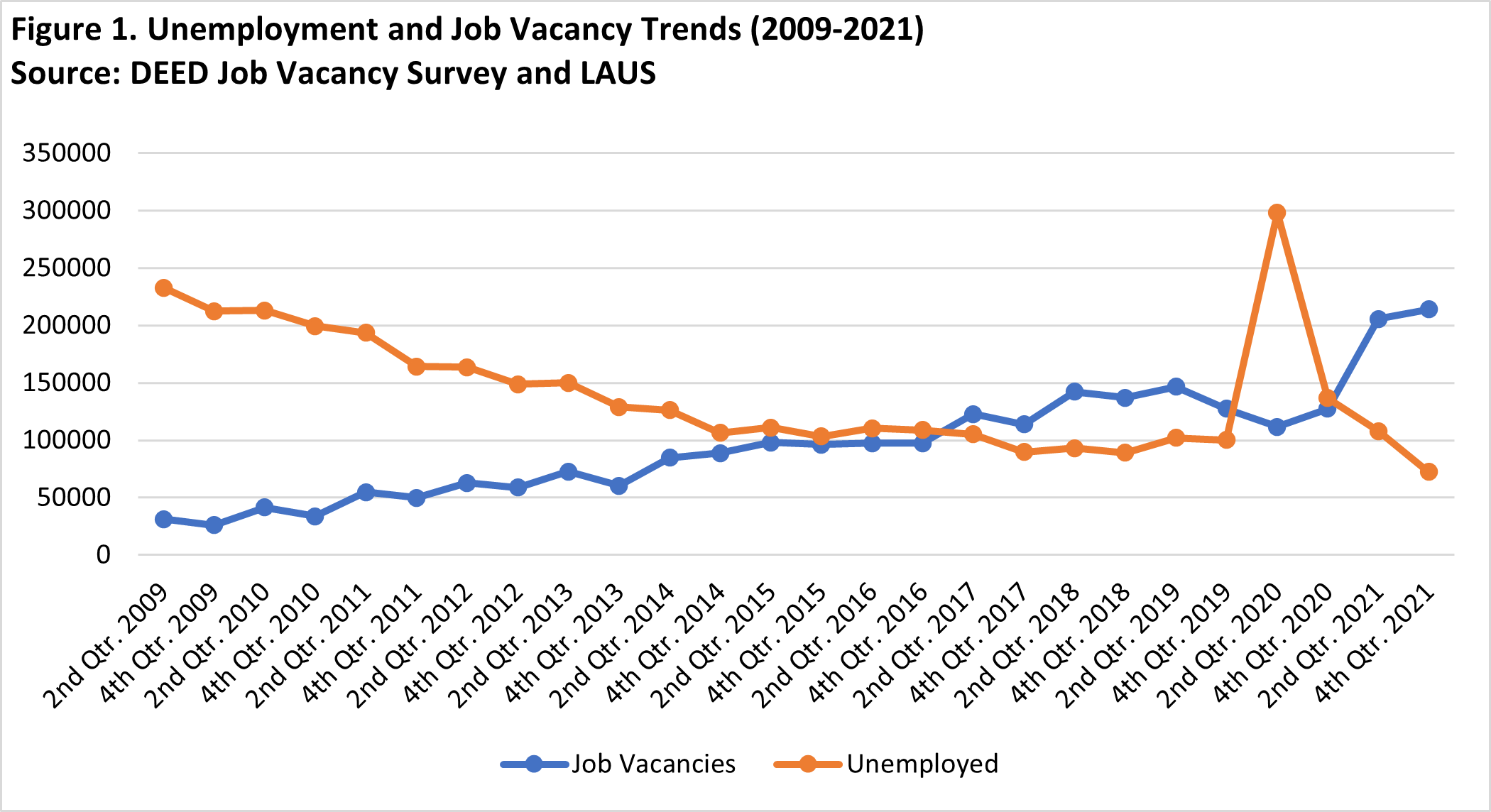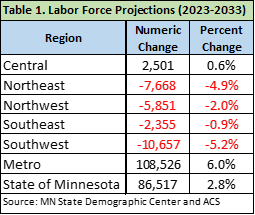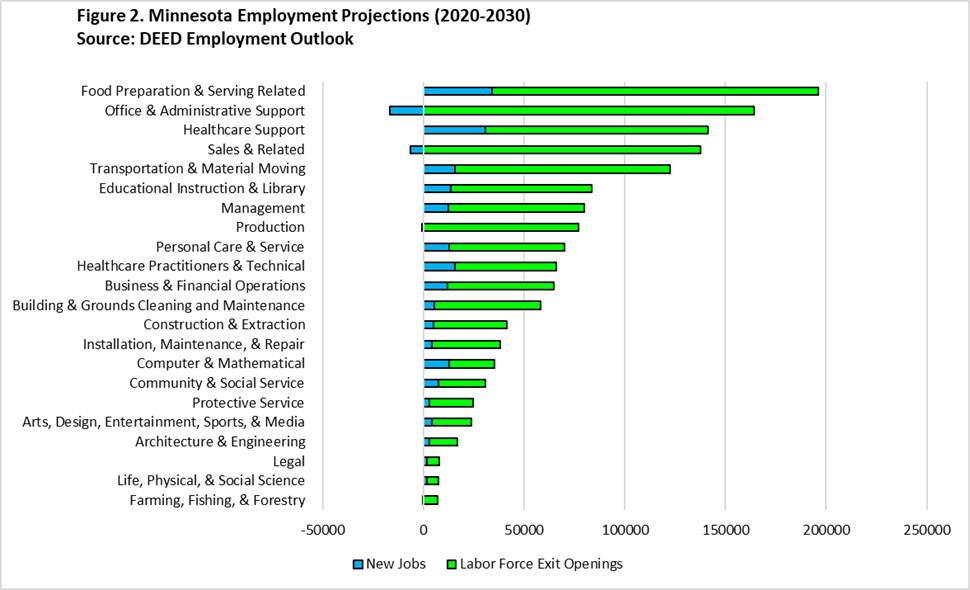by Mark Schultz – Workforce Development Specialist, Minnesota Department of Corrections and JoAnn Brown – Project Supervisor, Minnesota Department of Corrections
December 2022
Minnesota's extremely tight labor market makes it more important than ever to help connect formerly incarcerated individuals with employment. People who have served their time and are released into Minnesota communities need to find work to support themselves and their families. It is only fair to ensure that they are prepared to find such employment – and that employers are prepared to hire them.
The Minnesota Department of Corrections (DOC) has a long-standing program called EMPLOY that helps prepare incarcerated individuals for employment before their release, connect them with employers after their release and provide follow-up services to help make sure they remain employed in work that is a good fit for them. Two newly announced programs led by the Minnesota Department of Employment and Economic Development (DEED), in coordination with DOC and the U.S. Departments of Justice and Labor, will amplify those efforts.
The state-funded Pilot Re-Entry Program Competitive Grant program and the federally-funded Partners for Reentry Opportunities in Workforce Development (PROWD) program are also aimed at preparing formerly incarcerated individuals for employment, connecting them with employers and providing supportive services to help members of Minnesota's second chance workforce succeed.
This article focuses on the DOC EMPLOY program, why it is needed and its proven successes.
Created in 2006, the DOC EMPLOY Program is a voluntary employment service program providing work readiness and job search preparation for individuals who have 24 months or less to serve in their sentence. The program's mission is to reduce recidivism by providing participants with the necessary tools to locate, obtain and retain gainful employment. This is accomplished through: offering work readiness and job search training; providing education to employers about creating fair hiring practices within their companies and the benefits of hiring from the second chance population; connecting skilled participants with appropriate job leads; offering follow-up support; and encouraging positive change.
A DOC evaluation of EMPLOY conducted in 2021 showed that people who participated in the EMPLOY program were nearly three times as likely to find employment and nearly 60% less likely to become reincarcerated within two years after release. Even those participants who started in the EMPLOY program but did not complete it saw benefits in terms of lower rearrest, reconviction and repeat incarceration than those who never participated in the program. The research evaluated outcomes for 2,814 individuals released from Minnesota correctional facilities between 2009 and 2018.
Participants who completed EMPLOY had lower rates of four types of recidivism
*Results were statistically significant at p<.001
The results of this analysis lend support to previous studies that show the important role employment plays in decreasing recidivism (Uggen 1999; Crutchfield and Pitchford 1997).
Formerly incarcerated individuals have long faced barriers to employment (Decker et al. 2015; Uggen and Staff 2001) (Pager 2003). The inability to find employment because of those barriers could lead to future criminality (Needels 1996). The EMPLOY Program prepares participants for successful reentry into the world of work, helps them stay employed, and attempts to provide the skills necessary for participants to gain employment in jobs that not only pay well, but are also a good fit for them. The bonus for employers is that this population can help fill the employment void left by historically low unemployment and high job vacancy numbers.

As shown in Figure 1, since the Great Recession the number of job openings has rather steadily increased while the number of unemployed people in the state has decreased (with the exception of the COVID-induced spike in the second quarter of 2020). In fact, the data show that the number of job vacancies in Minnesota increased by over 182,000 from second quarter 2009 to fourth quarter 2021, a leap of 583%, while the number of unemployed persons dropped by over 160,000 for a decline of 69%. These trends culminated with the highest number of vacancies the state has ever seen and the second lowest unemployment count on record. In addition, while the timeframe is limited due to the availability of job vacancy data (the most recent data available is for fourth quarter 2021), the most recent data on the number of unemployed people (October 2022) shows that it had increased slightly to a still very low count of 65,873 unemployed individuals statewide!
There are 3.5 job openings for every job seeker in Minnesota, as of September, the latest month for which such data is available. Thus, the EMPLOY Program is a critical element in alleviating some of the stress many employers are feeling from not being able to find workers to fill their job openings. While there are some jobs that are off limits to the second chance population (at least for a while after release), the men and women who fall into this category can be exceptional workers and many leave their respective correctional facilities with the skills, training and credentials that employers are looking for. .
 Helping formerly incarcerated individuals join and remain in the labor force is critically important for employers given Minnesota labor force projections that show the state is expected to gain only about 86,500 labor force participants from 2023 to 2033 for a growth of only 2.8%. The bulk of those gains are in the Metro region (up 108,526) as well as among 45- to 54-year-olds (up 89,865), while those in the next age bracket, 55- to 64-year-olds, are slated to see a decrease of just over 81,000 labor force participants. In addition, while the state as a whole is projected to see an increase in the labor force during this 10-year period, not every region in the state is projected to see labor force gains. For example, Southwest Minnesota is expected to see over 10,000 fewer labor force participants while the Northeast, Northwest, and Southeast regions are also projected to see their respective labor forces decline. See Table 1.
Helping formerly incarcerated individuals join and remain in the labor force is critically important for employers given Minnesota labor force projections that show the state is expected to gain only about 86,500 labor force participants from 2023 to 2033 for a growth of only 2.8%. The bulk of those gains are in the Metro region (up 108,526) as well as among 45- to 54-year-olds (up 89,865), while those in the next age bracket, 55- to 64-year-olds, are slated to see a decrease of just over 81,000 labor force participants. In addition, while the state as a whole is projected to see an increase in the labor force during this 10-year period, not every region in the state is projected to see labor force gains. For example, Southwest Minnesota is expected to see over 10,000 fewer labor force participants while the Northeast, Northwest, and Southeast regions are also projected to see their respective labor forces decline. See Table 1.
As mentioned above, the most recent job vacancy estimates show that Minnesota currently has the highest number of job openings on record. However, it doesn't stop there as there is projected to be job growth of 5.7% from 2020 to 2030, equaling almost 170,000 new jobs statewide. In addition, the state is anticipated to see almost 1.3 million job openings due to labor force exits (such as retirements) during this time. The largest number of new jobs are expected to be in Food Preparation & Serving Related (up 33,983) and Healthcare Support (up 30,718) while the largest amount of labor force exit openings are projected in Office & Administrative Support (up 164,380) and Food Preparation & Serving Related (up 162,071) (see Figure 2). Also shown in figure 2 are the employment projections for the remaining occupational groups in Minnesota. What stands out is that while not every occupational group is projected to see job growth (new jobs), every single one is anticipated to see openings due to labor force exits. And while some of these occupations may be out of reach for some second chancers, such as some positions in health care, there are plenty of other employment opportunities in Minnesota for the men and women being released from prison.

EMPLOY starts prior to release. During incarceration, participants receive program packets to work on independently to: assess individual levels of work readiness and career interest; identify hard, soft and transferable skills; set goals and work on activities to reduce or eliminate barriers for a successful transition for release. Based on each individual's level of work readiness and risk, participants engage in a variety of job search preparation trainings: employment seminars on targeted specific job search topics; a 2-day job search session facilitated by a Workforce Development Specialist covering a wide variety of job search topics, and for those that need more structured time, a 33-session Cognitive Behavioral Intervention Employment Training is available.
Once in the community, participants work one-on-one with a retention specialist to develop an individual job search plan. Additionally, participants receive an electronic portfolio and resume, specific job leads based on interest, skills, training, and availability at time of release, and/or referrals to community partners for additional training, services, or educational opportunities. Post release check-ins and follow-up contacts occur within the first week of release, at one month out and then every three months up to the 1-year post release visit. Check-ins may be in person, virtual, by phone, mail, text messaging, or whatever means works for the individual. These post-release services are critical to ensure participants retain their employment once released and hired.
Given that there are far fewer unemployed individuals than there are job openings in Minnesota, employers are currently experiencing difficulties filling job openings and will likely continue to face hiring challenges in the foreseeable future. EMPLOY's job developer works with employers to help them identify their workforce needs and desired skills, as well as training and certifications requirements. The job developer also discusses hiring practices, markets skills and experience of specific candidates, and informs employers of the Work Opportunity Tax Credit and Federal Bonding Employer Incentives. An Employer LinkUp! database is used to enter the employer information and may be accessible to any DOC staff who is working with an individual on their job search. Additionally, DOC relationships with community partners throughout the state increase opportunities for released individuals to gain access to the programming and services that will benefit them the most based on job interest and skills needed to succeed.
Minnesota and much of the country are experiencing a very tight labor market. Employers continue to struggle to fill their job openings, with some decreasing the hours they are open or even closing some locations because they can't find enough workers. While this is a very difficult situation for employers, it presents opportunities for those looking for work, particularly those who may have been ignored in the past, such as people with a criminal record. Some Minnesota employers are revising their policies to help bring more second chance workers onboard. Another plus for workers: many employers are increasing wages and offering hiring and retention bonuses to attract applicants. For example, for a limited time some new hires for the DOC may be eligible for a $10,000 hiring bonus if they are hired at select correctional facilities.
The DOC EMPLOY Program helps not only program participants, but also the businesses who will hire participants. DOC has expanded participant access to EMPLOY allowing many more incarcerated persons to take advantage of this program, obtain gainful employment, have lower chances of recidivism and achieve more job success.
Crutchfield, Robert & Susan Pitchford (1997). Work and Crime: The Effects of Labor Stratification. Social Forces, 76(1), 93-118.
Decker, Scott, Natalie Ortiz, Cassia Spohn, & Eric Hedberg (2015). Criminal Stigma, Race, and Ethnicity: The Consequences of Imprisonment for Employment. Journal of Criminal Justice, 43(2), 108–121.
McNeeley, Susan (2021). A Long-Term Follow-Up Evaluation of an Employment Assistance Reentry Program. Justice Evaluation Journal, 5(1), 90-108.
Needels, Karen E. (1996). Go Directly to Jail and Do Not Collect? A Long-Term Study of Recidivism, Employment, and Earnings Patterns Among Prison Releases. Journal of Research in Crime and Delinquency, 33(4), 471–496.
Pager, Devah (2003). The Mark of a Criminal Record. American Journal of Sociology, 108(5), 937–975.
Solomon, Amy, Kelly Dedel Johnson, Jeremy Travis, & Elizabeth McBride (2004). From Prison to Work: The Employment Dimensions of Prisoner Reentry. Washington, DC: Urban Institute
Uggen, Chris (1999). Ex-Offenders and the Conformist Alternative: A Job Quality Model of Work and Crime. Social Problems, 46(1), 127-149.
Uggen, Chris, & Jeremy Staff (2001). Work as a Turning Point for Criminal Offenders. Corrections Management Quarterly, 5(4), 1–16.
Visher, Christy, Sara Debus, & Jennifer Yahner (2008). Employment After Prison: A Longitudinal Study of Releases in Three States. Washington, DC: The Urban Institute.